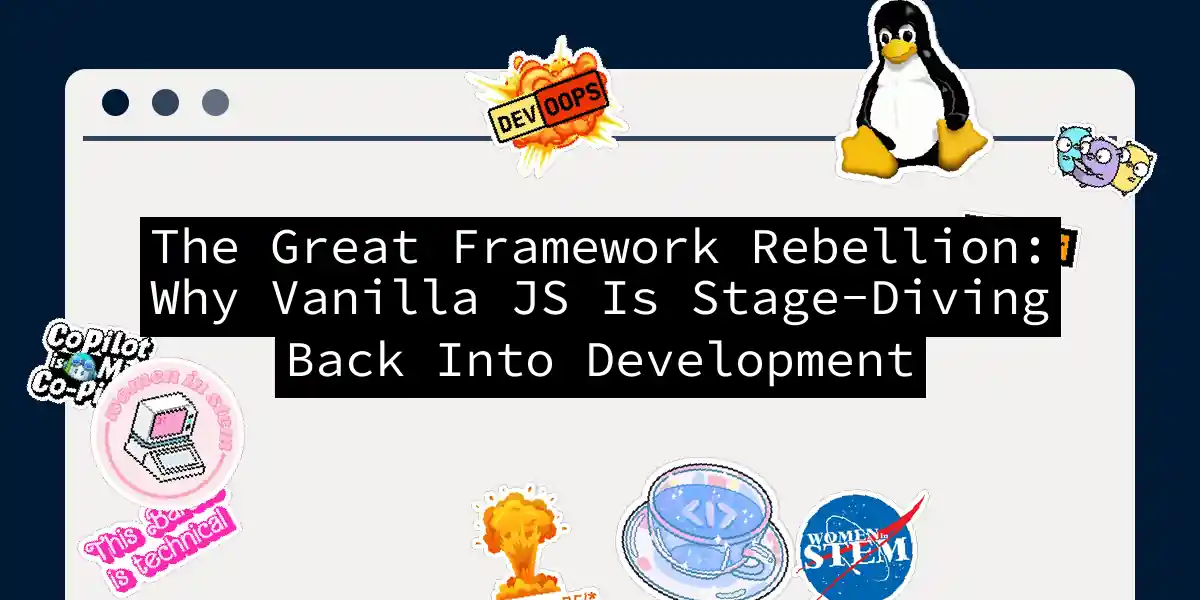The JavaScript landscape feels like a never-ending music festival: Every year, a new headline act takes the main stage while yesterday’s rockstars fade into nostalgia. But in 2025, there’s a surprising encore performance—the triumphant return of vanilla JavaScript. Forget the mosh pit of framework hype; we’re witnessing a full-blown rebellion where developers are rediscovering the raw power of native browser capabilities. Buckle up, because we’re tearing down the wall of abstraction and rebuilding with pure, unadulterated JS.
🎸 Why Developers Are Rioting Against Framework Overload
Remember when jQuery was the ultimate guitar solo? Then Angular, React, and Vue became the headliners. But lately, I’ve noticed something backstage: Developers are exhausted from the endless toolchain tap dance. One npm audit away from existential crisis, we’re questioning if we really need 200 MB of node_modules to render a button.
Modern browsers have evolved into capable beasts. APIs like fetch(), IntersectionObserver, and Web Components aren’t opening acts—they’re feature-complete rockstars. Need state management? Proxy objects handle reactivity natively. Routing? The Navigation API is surprisingly robust. When browsers finally agreed on standards, they didn’t just whisper—they screamed: “You don’t need a framework for everything!”.
The Performance Mosh Pit
Let’s talk numbers. A React “Hello World” clocks in at ~150KB gzipped. The vanilla equivalent? Under 1KB. When your user is on a dodgy train wifi or a $20 burner phone, that difference isn’t academic—it’s the gap between engagement and abandonment. Frameworks are like amp stacks: awesome for stadiums, overkill for coffee shops. Not every project needs pyro.
// Vanilla state management in 2025 - No frameworks needed!
const state = new Proxy({ count: 0 }, {
set(target, key, value) {
target[key] = value;
document.getElementById("counter").textContent = value;
return true;
}
});
document.querySelector("button").addEventListener("click", () => {
state.count++;
});
🔧 Building a Framework-Free Component: The “Rebel Toggle”
Enough theory—let’s build something dangerously simple. We’ll create an accessible theme toggle. No JSX, no virtual DOM, no existential dread.
Step 1: HTML Structure
<button id="theme-toggle" aria-pressed="false">
🌙 Dark Mode
</button>
Step 2: CSS for State Management
:root {
--bg: white;
--text: black;
}
[data-theme="dark"] {
--bg: #1a1a1a;
--text: #f0f0f0;
}
body {
background: var(--bg);
color: var(--text);
transition: all 0.3s ease;
}
Step 3: Vanilla JavaScript That Slaps
const toggle = document.getElementById("theme-toggle");
toggle.addEventListener("click", () => {
const isPressed = toggle.getAttribute("aria-pressed") === "true";
// Toggle state and UI
toggle.setAttribute("aria-pressed", String(!isPressed));
document.documentElement.dataset.theme = isPressed ? "light" : "dark";
// Update text (because emojis are serious business)
toggle.textContent = isPressed ? "🌙 Dark Mode" : "☀️ Light Mode";
});
Why this rocks: Zero dependencies, 500 bytes, and it works before your React hydration script finishes yawning. The browser handles everything—no diffing algorithms needed.
🗺️ When to Go Vanilla: Your Framework Decision Matrix
Not every project needs a rebellion. Use this cheat sheet:
🛠️ Advanced Rebellion Tactics
Think vanilla JS means spaghetti code? Think again. Modern patterns keep things clean: Web Components for Encapsulation:
class RebelToast extends HTMLElement {
constructor() {
super();
this.attachShadow({ mode: "open" });
this.shadowRoot.innerHTML = `
<style>/* Scoped styles */</style>
<div class="toast">${this.getAttribute("message")}</div>
`;
}
}
customElements.define("rebel-toast", RebelToast);
State Management with Custom Events:
// Dispatch events instead of prop drilling
document.dispatchEvent(
new CustomEvent("user-updated", { detail: { id: 42 } })
);
// Listen anywhere
document.addEventListener("user-updated", (e) => {
console.log("User updated:", e.detail.id);
});
🎤 The Encore: Is This Just Nostalgia?
Absolutely not. This isn’t “going back”—it’s moving forward with purpose. Frameworks still dominate complex SPAs, but vanilla JS has reclaimed its territory for:
- Performant microsites
- Embedded widgets (stop loading React for a button!)
- Progressive enhancement
- Tools where bundle size = revenue.
As browser capabilities explode (hello, View Transitions API), the gap between vanilla and frameworks narrows. The rebellion isn’t about burning down React—it’s about choosing the right tool without peer pressure. So next time you
npx create-react-app, ask yourself: “Would vanilla JS rock this?” Sometimes the answer is yes—and that’s okay. The stage is yours: Are you joining the rebellion, or sticking with your framework comfort zone? Drop your hot takes in the comments—let’s start a mosh pit of ideas! 🤘
